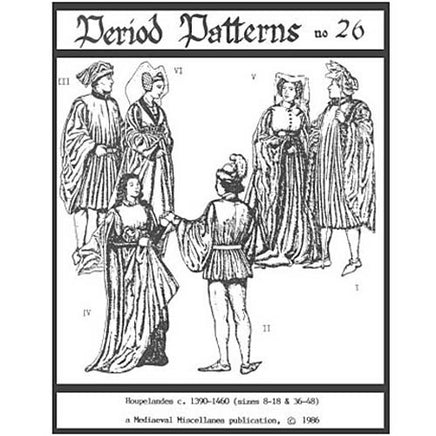
High Medieval Houpelandes
Period Patterns number 26, Houpelandes, c. 1390-1460 A.D., has 6 houpelandes for either sex, with sleeves and necklines interchangeable. The sleeves and cotehardie underneath are faked, but the fake sleeves can be left off and replaced by a cotehardie or a 2nd houpelande (sizes: woman's 8-18 & Men's 36-48 included).
These are complimented by Period Patterns no. 21, 23, 43, 90, 92, 93 and 101.
Houpelandes were the last fashion which was found throughout Europe, as well as being the last unisex fashion. This comfortable style, flowing from the shoulder to the hem, apparently first developed in Italy around 1380, but by 1400 was found throughout Europe. Belted or loose, houpelandes were usually worn over a cotehardie (Period Patterns nos. 21 & 23) ,a second houpelande with tight sleeves, a chemise (Period Patterns no. 90) ,or shirt (Period Patterns no. 43) and hose (Period Patterns no. 43 or 101).
By 1450 there were many variations of this style, mostly of the sleeves, neckline. Women's houpelandes were always floor-length, although men's houpelandes varied from very short to very long. Only a few were limited by sex or geographical location. By 1475 houpelandes were no longer considered fashionable (although still occasionally seen). Men's cotehardies had developed into doublets, and the houpelande became a gown or robe often worn open down the front (Period Patterns #43 and 53).
Zelikovitz Leathers is an Official Distributor of Mediaeval Miscellanea Period Patterns and stocks the full line of available patterns.
Mediaeval Miscellanea has created copyrighted Period Patterns for sewing authentic period clothing. The patterns, designed by professional costumers, are rigorously researched to ensure historical authenticity. Each package includes complete, full sized cutting patterns in all sizes listed on the envelope (which permits easier custom fitting; sizes are based on standard commercial pattern sizes and can easily be scaled up or down to create additional sizes). Detailed, fully illustrated, step-by-step sewing instructions are provided in addition to general instructions (seam finishes etc.), and most patterns include suggested pattern layout.
Each pattern package contains historical notes with illustrations from contemporary sources providing background information, as well as possible enhancements and variations. On the back of the package additional important information is provided including garment description (with country and approximate dates where possible), sizing, notions and yardage requirements for each size and suggested fabric type for each garment.
